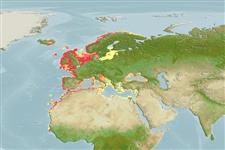分類 / Names
Common names from other countries
主要參考資料
大小 / 重量 / 年齡
Max length : 103 cm TL 雄魚/尚未辨別雌雄; (Ref. 40637); common length : 50.0 cm TL 雄魚/尚未辨別雌雄; (Ref. 6916); 最大體重: 12.0 kg (Ref. 1468); 最大年齡: 30 年 (Ref. 59043)
Length at first maturity
Lm 32.3, range 23 - 46 cm
環境
; 海洋; 淡水; 半鹹淡水 居於水底的; 海洋洄游的; 深度上下限 10 - 100 m (Ref. 9987)
氣候 / 範圍
8°C - 24°C (Ref. 4944), preferred 11°C (Ref. 107945); 72°N - 11°N, 19°W - 42°E (Ref. 54221)
分布
Eastern Atlantic: Norway to Morocco, the Canary Islands and Senegal. Also known from the Mediterranean and Black Sea. Absent from White, Barents, Baltic and Caspian Seas (Ref. 59043).
國家 | FAO區域 | 生態系 | 發現紀錄 | 簡介
簡短描述
背棘 (總數): 8 - 10; 背的軟條 (總數): 12-13; 臀棘 3; 臀鰭軟條: 10 - 12. Diagnosis: head with cycloid scales above; mouth moderately protractile (Ref. 231). Vomerine teeth only anteriorly (Ref. 231), in a crescentic band (Ref. 231, 57391). Scales on interorbital space cycloid (Ref. 57391). Posterior edge of opercle finely serrated, lower edge with strong forward- directed denticles (Ref. 231). 2 flat opercular spines (Ref. 231, 57391). Young with some dark spots on upper part of body (Ref. 231).
人類使用
漁業: 商業性; 養殖: 商業性; 游釣魚種: 是的
工具
特別的報告
下載 XML
網路資源
Estimates of some properties based on models
Phylogenetic diversity index
PD50 = 0.7656 many relatives (e.g. carps) 0.5 - 2.0 few relatives (e.g. lungfishes)
營養階層
3.5 ±0.50 se; Based on food items.
回復力
中等的, 族群倍增時間最少 1.4 - 4.4年 (K=0.06-0.33; tm=2-8; tmax=30; Fec=230,000)
瀕危性
Moderate to high vulnerability (49 of 100)
價格種類
